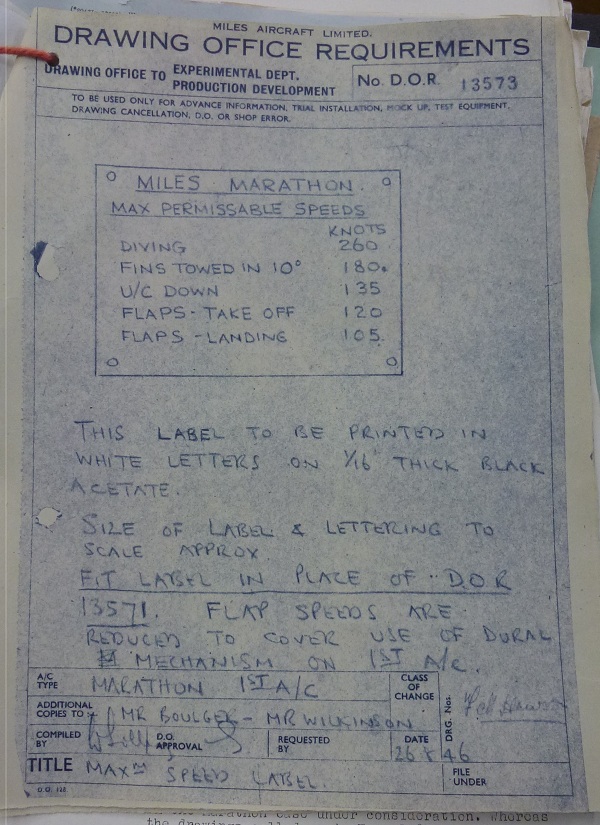

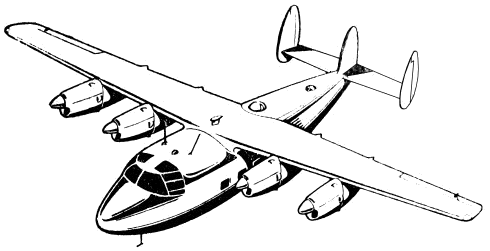
The Flight
The first prototype Marathon, G-AGPD, was delivered to A&AEE at Boscombe Down on 20th April 1948 for acceptance trials with the Civil Air Test Section there. It then undertook a long series of flight tests to verify its suitability for service. The aircraft was also involved in a succession of 'engine cut' take-offs, whereby an engine was throttled back or fully shut down on take-off, as part of a comprehensive investigation into take-off techniques on a wide variety of aircraft types. The later AIB Accident Report erroneously stated that these tests were specifically done to assess the Marathon's unique toed-in fin feature (see below) - but this feature was used during the 'engine cut' trials simply because it was part of a normal takeoff configuration on the Marathon prototype.
On 27th May 1948, Flt Lt Brian Bastable conducted one such flight and reported that the tail of the aircraft had touched the runway. Inspection was made post-flight but discovered only that, "...there were marks of a slight graze upon tarmac on the bottom fairings of both fin and rudder on the starboard side. The marks were of slight depth with no torn metal". The aircraft was then passed as fit for flight and Bastable made a further sortie of a half hour, with two further 'engine cut' take-offs being made by another pilot on the morning of 28th May. No abnormality of handling was noted.
Brian Bastable took G-AGPD aloft again at 2.02pm to take part in a flypast over Boscombe Down for staff of the Imperial Defence College, who were visiting the station. He was then to carry out timings for propeller feathering. Also aboard was Miss Beryl Rosemary Edmonds, as Technical Observer. The aircraft departed at its maximum take-off weight (for the time) of 16,500 lb and with its centre of gravity at 35.6 inches aft of datum. For around 25 minutes all appears to have gone to plan, though there are no records of its movements during the initial phase of flight. However for at least some of the flight it was seen performing wide flat turns, awaiting its slot. Since the aircraft was at the tail of a group of different types doing flypasts, Flt Lt Bastable had to circulate in the local area until contacted to begin his approach. At 2.26pm Boscombe Control gave clearance to perform his flypast but no reply was received. Witnesses stated that at this time the aircraft was in the vicinity of Middlecot Farm (near Thruxton in Hampshire), flying laterally and longitudinally level at about 1,000 feet, and heading towards Boscombe Down.
Shortly afterwards, a bang was heard and pieces of the tail unit were seen to break away from the aircraft, though the aircraft appeared to continue roughly on course, but now losing height and appearing unsteady. At 2.29 pm, Boscombe Control received the message, "I am about to crash" and it seems that Flt Lt Bastable was attempting to make a landing when the tail of the aircraft struck some trees and crashed vertically into the ground near to Middlecot Farm. Fire broke out upon impact and the machine was destroyed; Brian Bastable had been killed instantly and Miss Edmonds fatally injured. Their bodies were removed from the wreckage before the fire took hold. The crash site was approximately 8 miles northeast of Boscombe Down.
G-AGPD had flown 121 hours at the time of the accident.
Weather in the vicinity was 7 to 8 miles visibility, between 4 to 6/10 cumulo-stratus cloud at 2500 ft, 9/10 at 3500 ft with a surface wind from the southeast at 5 mph.

This is how G-AGPD would have looked on 28th May 1948, with its civil registration replacing the Miles test identification 'U-10'. (Gordon Swanborough via Peter Amos)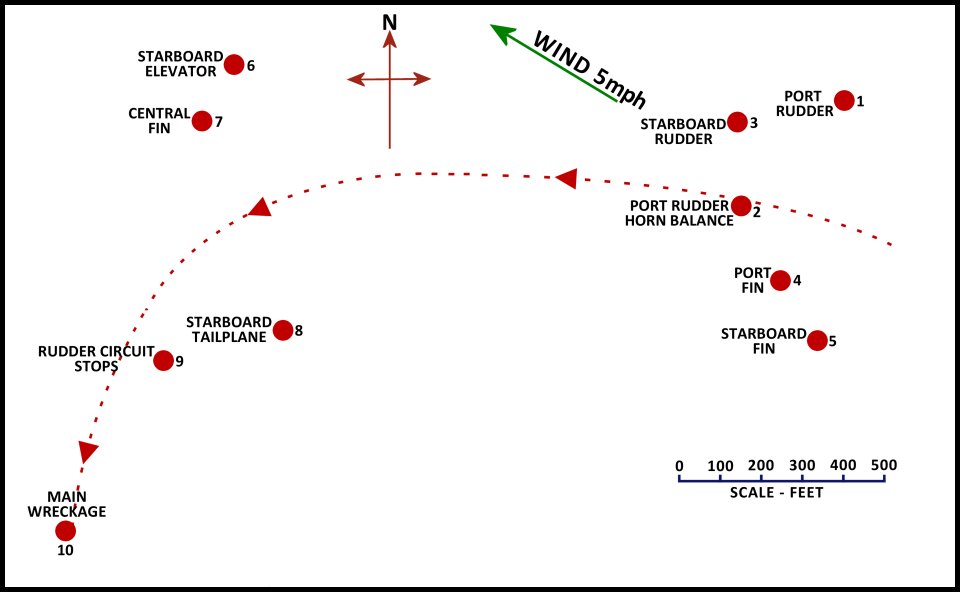
Map of the aircraft's wreckage trail. In its final moments it was flying from the east (right hand side of map) at approximately 700 feet.

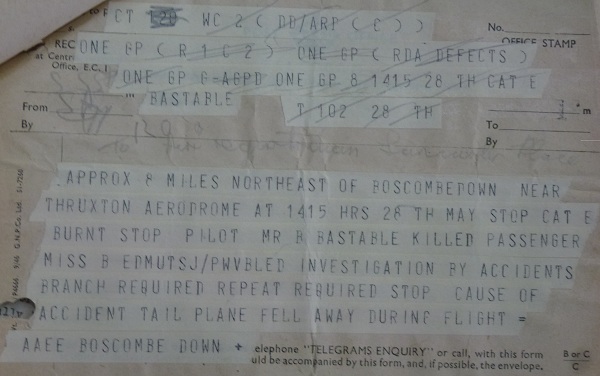
The Marathon's 'Toed-In' Tail Fins
Key to understanding this accident is an explanation of a feature which was installed on the first two M.60 Marathons and also on the sole Marathon 2. To assist in maintaining direction in the event of an engine failure on take-off (less of an issue on the 4-engined M.60, but likely to be more of an issue on the twin-Mamba engined Marathon 2), Miles had designed the aircraft so that the outer fins could be 'toed-in' at their leading edges by means of a control, operated by the pilot. Range of movement was from zero to 10 degrees inboard and the pivot axis was just forward of the rudder centreline. In use, the fins would be fully toed-in for take-of and once safety height had been reached, they would be returned to zero by the pilot.
At the time of the accident there was no cockpit label or indication in the aircraft's Certificate of Airworthiness (No.9695, issued on 3rd September 1948) of any speed limitation with the fins toed-in. It appears that such a placard had been in place when G-AGPD had first visited Boscombe Down, but during a subsequent period of modification at Woodley this notice had been replaced with one which omitted the speed limitation with the fins toed-in.
Adjustment of the fins was by means of an electrically-operated actuator mounted in the tip of the horizontal tailplane and connected to the forward spar of the fin. The fins pivoted on bearings located in the tailplane rear spar. The angle of the rudder in relation to the vertical fin was unaffected by toeing-in of the fins. Loads were mainly transmitted through the fin pivot bearings and into the tailplane rear spar.
With no production requirement for the twin-engined version, no other Marathons were fitted with this feature.
On the day following the crash, Accidents Investigation Branch staff visited the site and were able to confirm that structural failure of the tail unit had occurred with the fins fully toed-in, whilst the aircraft was flying downwind from east to west at a comparatively low altitude. Resting at a distance from the wreckage, the team found the outer fins and rudders. Some way further on towards the main fuselage they then discovered the starboard tailplane and the central fin, plus smaller items.
Notable among the wreckage was a marking, described as, "streaks of some bituminous substance...indicative of fairly heavy contact with a runway or tarmac" at the base of the starboard fin and rudder. Approximately an inch had been ground away at the base of the rudder, and deemed to have been associated with the markings; neither were caused by the disintegration or subsequent crash. There were no other indications of defect or pre-crash damage to the airframe, engine or controls.
The wreckage was initially removed to Boscombe Down and then on to RAE Farnborough for detailed examination by the Structures Department.
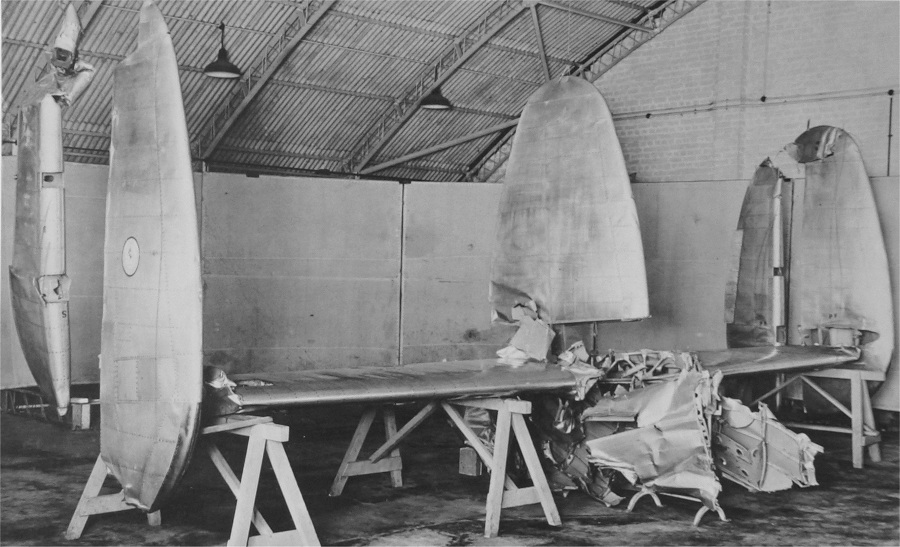
Conclusions
The RAE reconstructed the Marathon's tailplane to help ascertain the sequence and ultimate cause of the accident. It found that primary failure had occurred in the lower brackets attaching the fins to the tailplane rear spar, probably during a turn to port, with the rudders at 6 degrees offset. The fins and rudders then folded inward from the top and impacted the tailplane rear spars. Final separation of the fins and rudders then occurred by outward override of the rudders. Such a failure was calculated to be possible if the fins were toed-in at their maximum, with no rudder deflection, for speeds as low as 240 kt. Following the fin failure, both elevators had rotated hard downwards but the starboard tailplane had failed following a hard upwards movement of its associated elevator. The central fin had failed separately during the uncontrolled yawing after the fins had detached, and further investigation confirmed that it had failed to port.
The RAE findings were issued in Technical Note 33 and this was attached as an appendix to the AIB Accident Report (C.521), which was published on 28th January 1949. The RAE appendix stated as follows,
There is no evidence of weak or defective material in the failed components. Primary structural failure occurred in the outer fins and rudders. When the failure occurred the fins were 'toed-in' 10 degrees and the aerodynamic loads on them were sufficient to produce failure. Calculations show that when the fins are toed-in by this amount they can be expected to fail at a speed of 235 kts EAS in straight flight. Failure can be expected at a lower speed if the aircraft is yawed, or the rudders are deflected, or horizontal gusts occur.
The strength of the aircraft for flight with fins toed-in was such as to demand prominent statement of a speed limitation for this condition and its careful observance; it is understood that a limit of 180 kt was fixed by the firm. This limit was on the unconservative side for structural safety, in that it left little margin of strength for manoeuvring or horizontal gusts at that speed.
The centre fin and starboard tailplane failures were secondary. These parts broke away in the unstable yawed flight which followed the failure of the outer fins. The ground impact damage at the bottom portions of the starboard fin and rudder did not contribute to the primary failure.
It is also worth re-stating the starting point for this accident, which was undoubtedly the lack of any warnings indicating the speed limitations with the fins toed-in. It was never fully explained why the initial cockpit warning placrd had been removed, nor why there was no other record in the aircraft's documentation. Coupled to these errors, the aircraft had low safety margins with the fins toed-in and by present-day standards it seems unreasonable for the pilot to be responsible for ensuring that speeds were not exceeded for certain aircraft configurations (had they been known). Nowadays such operations would be automatically performed and at the very least subject to audible and visible warnings.
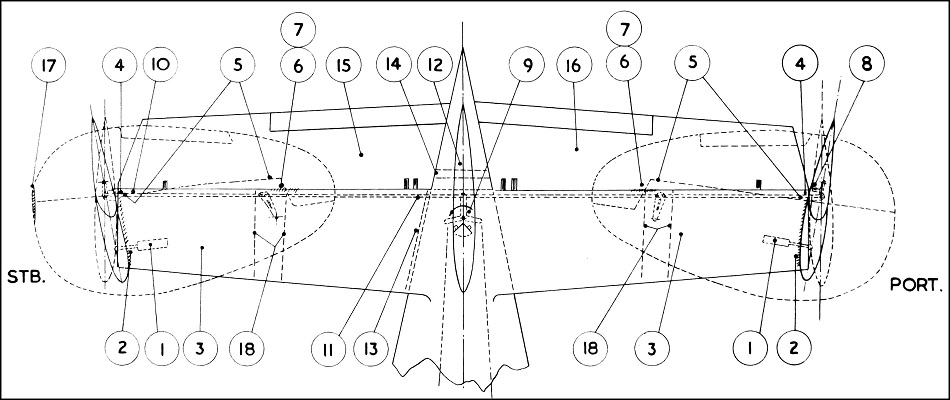
This schematic was created by the crash investigation team to map the key features of the tailplane wreckage. It is interesting as it shows at (1) the unique 'toe-in' actuators that were only fitted on the prototypes. Key: 1-Fin actuator jacks set to maximum 'toed-in' position of fins. 2-Tailplane upper surfaces damaged during fins' detachment. Line of damage indicates fins 'toed-in' to the maximum. 3-Fins and rudders collapsed inwards on to tailplanes. Primary failures occurred in fin to tailplane lower attachment brackets. 4-Rudder operating tubes damaged at outer ends during fin and rudder failure. Damage indicates rudders set at 6 degrees to port. 5-Rudder hinges failed with rudders rotating outward relative to fins. 6-Fin tops and rudder horns damaged when together, by tailplane rear spar upper booms during (3). 7-Tailplane upper surfaces damaged by fins and rudders - see (6). 8-Port rudder lever moved bodily inboard to damage end rib of tailplane. 9-Rudder circuit tee lever failed after rotating hard by stops in direction shown by arrow. 10-Rudder circuit tube in starboard tailplane damaged by tailplane end rib at two points, with tube (a) at limit position to starboard, (b) beyond limit position. 11-Rudder circuit tube failed by bending tip upward at tailplane root. 12-Centre fin failed by top moving to port and spar attachment bolts shearing. 13-Starboard tailplane failed under upload. 14-Starboard elevator torque tube failed at root by bending tip upward. 15-Starboard elevator separated from tailplane after rotating hard down and then up on its hinges. 16-Port elevator rotated hard down only. 17-Bottom portions of starboard fin and rudder damaged by rubbing on runway. 18-Tailplane ribs adjacent to rudder circuit idler lever damaged by excessive outward circuit movement. Rib bruised in port tailplane and broken in starboard tailplane.
The Crew
Brian Bastable was born on 13th August 1922 at Ulverston in Lincolnshire, making him 25 at the time of the accident. He had served in the RAF from March 1941 until September 1947. As an NCO pilot he gained his wings in June of 1942 and in September 1943 was appointed to a commission in the RAF Volunteer Reserve as a Pilot Officer on probation. He was confirmed in his rank as a Flying Officer on 19th March 1944, by which time he was serving with No.210 Squadron, flying Catalina amphibians. On 18th May 1944, Bastable was piloting Catalina JX243, which sank the German submarine U-241 northeast of the Shetland Islands. It was an engagement that earned him the Distinguished Flying Cross, his June 1944 citation reading, "Recently this officer piloted an aircraft in an engagement against a U-boat. In spite of intense opposing fire, Flying Officer Bastable pressed home his attack, which ended with the destruction of the enemy vessel. In this spirited action, this officer displayed skill and determination of a high order. He has completed much operational flying and throughout has set a fine example." Brian Bastable was promoted to Flight Lieutenant rank on 19th September 1945.
Flt Lt Bastable completed the Empire Test Pilots School course in 1946 and following this he was posted to the Marine Aircraft Experimental Establishment, Felixtowe as a test pilot. There he was graded with an 'average' rating as a test pilot and was unsurprisingly rated 'above average' as a flying boat pilot.
At the time of his death he was employed by the Civil Air Test Section at A&AEE Boscombe Down, having been there since leaving the Air Force. From September 1947 he had piloted such diverse types as Avro Tudor, Vickers Viking, Gloster Meteor and Avro York. He had first flown the Marathon on 25th May, just three days prior to the accident. His total experience on the type was just 3.5 hours.
Sadly, little is known about the Observer on this flight, Miss Beryl Edmonds (not 'Edmunds' as often stated), who was just 20 at the time of the accident. It is assumed (because of her age) that she had not been at Boscombe Down for long, though her name appears on an earlier A&AEE crew list for G-AGPD in October 1946.
